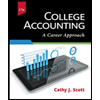
Concept explainers
(a)
Accounts receivable
Accounts receivable refers to the amounts to be received within a short period from customers upon the sale of goods, and services on account. In other words, accounts receivable are amounts customers owe to the business. Accounts receivable is an asset of a business.
Bad debt expense:
Bad debt expense is an expense account. The amounts of loss incurred from extending credit to the customers are recorded as bad debt expense. In other words, the estimated uncollectible accounts receivable are known as bad debt expense.
Aging of receivables:
A method of determining the estimated uncollectible receivables based on the age of individual accounts receivable is known as aging of receivables method.
Allowance method:
It is a method for accounting bad debt expense, where uncollectible accounts receivables are estimated and recorded at the end of particular period. Under this method,
Direct write-off method:
This method does not make allowance or estimation for uncollectible accounts, instead this method directly write-off the actual uncollectible accounts by debiting bad debt expense and by crediting accounts receivable. Under this method, accounts would be written off only when the receivables from a customer remain uncollectible.
Write-off:
Write-off refers to deduction of a certain amount from accounts receivable, when it becomes uncollectible.
To Journalize and post: The
(a)
Answer to Problem 8.3AP
Journalize the adjusting entry to record the bad debt expenses at December 31, 2016.
| Date | Particulars | Debit | Credit |
| December 31, 2016 | Bad debt expense | $34,400 | |
| Allowance for doubtful accounts | $34,400 | ||
| (To adjust the bad debt expense) |
Table (1)
Allowance for doubtful accounts:
| Allowance for doubtful accounts | |||||
| Date | Particulars | Debit | Date | Particulars | Credit |
| 2016 | December 31, 2016 | Balance (Unadjusted) | $8,000 | ||
| December 31, 2016 | Bad debts (Adjusting) (Balancing figure) | $34,400 | |||
| Total | $0 | Total | $42,400 | ||
| Ending balance | $42,400 | ||||
Table (2)
Bad debt expense:
| Bad debt expense | |||||
| Date | Particulars | Debit | Date | Particulars | Credit |
| December 31, 2016 | Allowance for doubtful accounts (Adjusting) (Balancing figure) | $34,400 | |||
| Total | $34,400 | Total | $0 | ||
| Ending balance | $34,400 | ||||
Table (3)
Working note:
The aging of accounts receivable indicates that the total estimated bad debts of the year 2016 are $42,400.
Calculate the amount of bad debt expense to be recorded in adjusting entry.
Alternative method to calculate the amount of bad debt expense to be recorded in adjusting entry using T-account of Allowance for doubtful accounts is as follows.
Allowance for doubtful accounts:
| Allowance for doubtful accounts | |||||
| Date | Particulars | Debit | Date | Particulars | Credit |
| 2016 | December 31, 2016 | Balance (Unadjusted) | $8,000 | ||
| December 31, 2016 | Bad debts (Adjusting) (Balancing figure) | $34,400 | |||
| Total | $0 | Total | $42,400 | ||
| Ending balance | $42,400 | ||||
Table (4)
Explanation of Solution
Allowance for doubtful accounts (contra asset account) normal balance is credit balance. It is given that company’s estimated bad debts of the year as per aging of accounts receivable is $42,400. Hence, to bring the allowance for doubtful account balance from $8,000 to $42,400, it is required to increase bad debt expense and allowance for doubtful accounts by $34,400.
Hence, an increase in bad debt expense (decrease in
(b)
To Journalize and post: The transactions and events made in 2017.
(b)
Answer to Problem 8.3AP
(1) Journalize the write-off of uncollectible.
| Date | Account Title and Explanation |
Debit ($) |
Credit ($) |
| March 1 | Allowance for Doubtful Accounts | 600 | |
| Accounts Receivable | 600 | ||
| (To record write-off the uncollectible accounts receivable) |
Table (5)
(2) Journalize the collection of $600 from a customer on May 1, whose account is written off on March 1, 2017.
| Date | Account Title and Explanation |
Debit ($) |
Credit ($) |
| May 1 | Accounts Receivable | 600 | |
| Allowance for Doubtful Accounts | 600 | ||
| (The reverse entry of write-off) | |||
| May 1 | Cash | 600 | |
| Accounts Receivable | 600 | ||
| (To record collection of cash on account) | |||
Table (6)
Post the adjusting entry to the Allowance for doubtful accounts:
| Allowance for doubtful accounts | |||||
| Date | Particulars | Debit | Date | Particulars | Credit |
| 2016 | December 31, 2016 | Balance (Unadjusted) | $8,000 | ||
| December 31, 2016 | Bad debts (Adjusting) (Balancing figure) | $34,400 | |||
| Total | $0 | Total | $42,400 | ||
| December 31, 2016 | Balance (After adjustment) | $42,400 | |||
| March 1, 2017 | Accounts receivable | $600 | May 1, 2017 | Accounts receivable | 600 |
Table (7)
Explanation of Solution
1. Company B judged $600 amount due from a customer is uncollectible. To record this write-off of uncollectible receivables, both allowance for doubtful accounts and accounts receivable must be decreased by $600. Hence, a decrease in Allowance for doubtful accounts (contra asset account) is debited with $600, and a decrease in accounts receivable (asset account) is credited with $600.
2. Company B recovered $600 from a customer, whose account is previously written off as uncollectible. Hence, Company B is required to reverse the entry, which is previously written off as uncollectible receivables. Hence, accounts receivable is debited to increase its balance by $600, and allowance for doubtful accounts is credited to increase its balance by $600.
Now, the collection of cash on account, increases cash and decreases accounts receivable by $600. Hence, an increase in cash (asset account) is debited and a decrease in accounts receivable (asset account) is credited with $600.
Allowance for doubtful accounts: Normal balance of an Allowance for doubtful accounts (contra asset account) is credit balance, therefore debit decreases Allowance for doubtful accounts balance and a credit increases Allowance for doubtful accounts balance.
(c)
To Journalize: The adjusting entry for recording the bad debt expenses at December 31, 2017.
(c)
Answer to Problem 8.3AP
Journalize the adjusting entry to record the bad debt expenses at December 31, 2017.
| Date | Particulars | Debit | Credit |
| December 31, 2017 | Bad debt expense | $38,100 | |
| Allowance for doubtful accounts | $38,100 | ||
| (To adjust the bad debt expense) |
Table (8)
Working note:
The aging of accounts receivable schedule indicates that the total estimated bad debts of the year 2017 are $36,700.
Calculate the amount of bad debt expense to be recorded in adjusting entry.
Alternative method to calculate the amount of bad debt expense to be recorded in adjusting entry using T-account of Allowance for doubtful accounts is as follows.
Allowance for doubtful accounts:
| Allowance for doubtful accounts | |||||
| Date | Particulars | Debit | Date | Particulars | Credit |
| December 31, 2017 | Balance (Unadjusted) | $1,400 | December 31, 2017 | Bad debts (Adjusting) (Balancing figure) | $38,100 |
| Total | $1,400 | Total | $38,100 | ||
| Ending balance | $36,700 | ||||
Table (9)
Explanation of Solution
Allowance for doubtful accounts (contra asset account) normal balance is credit balance. Company’s unadjusted balance in allowance for doubtful accounts is a debit of $1,400. It is given that company’s estimated bad debts of the year as per aging of accounts receivable is $36,700. Hence, to bring the allowance for doubtful account balance from debit balance of $1,400 to credit balance of $36,700, it is required to increase bad debt expense and allowance for doubtful accounts by $38,100.
Hence, an increase in bad debt expense (decrease in stockholders’ equity account) is debited with $38,100 and an increase in allowance for doubtful accounts (contra asset account) is credited with $38,100
Want to see more full solutions like this?
Chapter 8 Solutions
Financial Accounting: Tools for Business Decision Making, 8th Edition
- Please give me true answerarrow_forwardYou've been asked to evaluate a new 25-year callable, convertible bond issued by Nova Energy Inc.. The bond has a 6.5% annual coupon, a face value of $1,000, and a conversion price of $45. The company's stock currently trades at $38 per share. What is the conversion premium for this bond? a) $5 b) $6 c) $7 d) $8 e) $10arrow_forwardsubject general accountingarrow_forward
- Correct answer please this questionarrow_forwardNeed help this questionarrow_forwardBeta Ltd. manufactures a product and has provided the following contribution format income statement: • Sales (6,200 units) = $186,000 • Variable expenses = $99,200 • Contribution margin = $86,800 • Fixed expenses = $67,000 ⚫ Net operating income = $19,800 If Beta Ltd. sells 6,800 units, what is the total contribution margin?arrow_forward
- Solve this questionsarrow_forwardXYZ Corp. had a net income of $1,200 million and sales revenue of $22,500 million in 2022. The company's total assets were $10,000 million at the beginning of the year and $11,500 million at the end of the year. a) Compute the asset turnover ratio. b) Compute the profit margin ratio.arrow_forwardNeed help this question general accountingarrow_forward
 College Accounting (Book Only): A Career ApproachAccountingISBN:9781337280570Author:Scott, Cathy J.Publisher:South-Western College Pub
College Accounting (Book Only): A Career ApproachAccountingISBN:9781337280570Author:Scott, Cathy J.Publisher:South-Western College Pub College Accounting (Book Only): A Career ApproachAccountingISBN:9781305084087Author:Cathy J. ScottPublisher:Cengage LearningPrinciples of Accounting Volume 1AccountingISBN:9781947172685Author:OpenStaxPublisher:OpenStax College
College Accounting (Book Only): A Career ApproachAccountingISBN:9781305084087Author:Cathy J. ScottPublisher:Cengage LearningPrinciples of Accounting Volume 1AccountingISBN:9781947172685Author:OpenStaxPublisher:OpenStax College Financial AccountingAccountingISBN:9781305088436Author:Carl Warren, Jim Reeve, Jonathan DuchacPublisher:Cengage Learning
Financial AccountingAccountingISBN:9781305088436Author:Carl Warren, Jim Reeve, Jonathan DuchacPublisher:Cengage Learning Financial Accounting: The Impact on Decision Make...AccountingISBN:9781305654174Author:Gary A. Porter, Curtis L. NortonPublisher:Cengage Learning
Financial Accounting: The Impact on Decision Make...AccountingISBN:9781305654174Author:Gary A. Porter, Curtis L. NortonPublisher:Cengage Learning Financial AccountingAccountingISBN:9781337272124Author:Carl Warren, James M. Reeve, Jonathan DuchacPublisher:Cengage Learning
Financial AccountingAccountingISBN:9781337272124Author:Carl Warren, James M. Reeve, Jonathan DuchacPublisher:Cengage Learning





